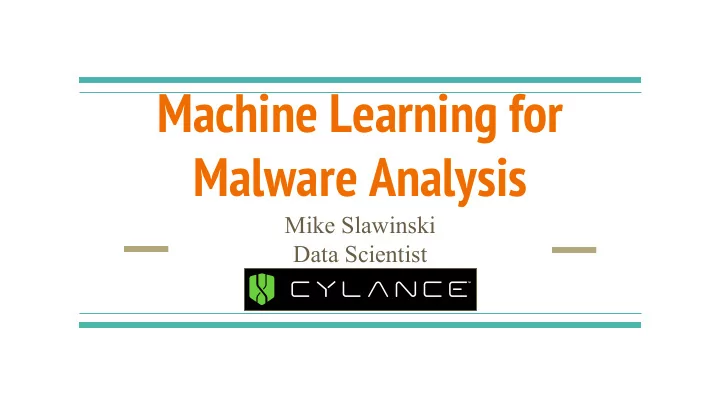

Machine Learning for Malware Analysis Mike Slawinski Data Scientist
Introduction - What is Malware? - Software intended to cause harm or inflict damage on computer systems - Many different kinds: - Adware/Spyware - Backdoors - Viruses - Ransomware - Botnets - Trojans - Rootkits - ... - Worms
Malware Detection - Hashing - Simplest method: - Compute a fingerprint of the sample (MD5, 7578034f6f7cb994c69afdf09fc487d9 SHA1, SHA256, …) - Check for existance of hash in a database of Query DB known malicious hashes - If the hash exists, the file is malicious Malicious Benign - Fast and simple - Requires work to keep up the database
Malware Detection - Signatures Look for specific strings, byte sequences, … in the file. If attributes match, the file is likely the piece of malware in question
Signature Example
Problems with Signatures - Can be thought of as an overfit classifier - No generalization capability to novel threats - Requires reverse engineers to write new signatures - Signature may be trivially bypassed by the malware author
Malware Detection - Behavioral Methods - Instead of scanning for signatures, examine what the program does when executed - Very slow - AV must run the program and extract information about what the sample does - Malicious samples can “run out the clock” on behavior checks
Scaling Malware Detection - Previously mentioned approaches have difficulty generalizing to new malware - New kinds of malware require humans in the loop to reverse-engineer and create new signatures and heuristics for adequate detection - Can we automate this process with machine learning?
Focus: Windows DLL/EXEs (Portable Executable) Number of samples submitted to VirusTotal, Jan 29 2017
Portable Executable (PE) Format
Feature Engineering - Static Analysis - What kinds of features can we extract for PE files? - Objective: extract features from the EXE without executing anything - PE-Specific features - Information about the structure of the PE file - Strings - Print off all human-readable strings from the binary - Entropy features - Extract information about the predictability of byte sequences - Compressed/encrypted data is high entropy - Disassembly features - Get an idea of what kind of code the sample will execute
PE-Specific Features https://virustotal.com/en/file/e328b2406d8784e54e77ccc7dbe8e3731891a703e6c21cf7e2f924fa8a42ea5c/analysis/
PE-Specific Features (cont.) https://virustotal.com/en/file/e328b2406d8784e54e77ccc7dbe8e3731891a703e6c21cf7e2f924fa8a42ea5c/analysis/
PE-Specific Features (cont.) https://virustotal.com/en/file/e328b2406d8784e54e77ccc7dbe8e3731891a703e6c21cf7e2f924fa8a42ea5c/analysis/
Feature Engineering - String Features - Extract contiguous runs of ASCII- printable strings from the binary - Can see strings used for dialog boxes, user queries, menu items, ... - Samples trying to obfuscate themselves won’t have many strings
Entropy Features - Interpret the stream of bytes as a time- series signal - Compute a sliding-window entropy of the sample - Information can determine if there are compressed, obfuscated, or encrypted parts of the sample “Wavelet decomposition of software entropy reveals symptoms of malicious code”. Wojnowicz, et. al. https://arxiv.org/abs/1607.04950
Disassembly Features - Contains information about what will actually execute - Disassembly is difficult: - Hard to get all of the compiled instructions from a sample - x86 instruction set is variable-length - Ambiguity about what is executed depending on where one starts interpreting the stream of x86 instructions
Difficulties for Static Analysis - Polymorphic code - Code that can modify itself as it executes - Packing - Samples that compress themselves prior to execution, and decompress themselves while executing - Can hide malicious behavior in a compressed blob of bytes - Can obscure benign code as well - Requires expensive implementation of many unpackers (UPX, ASPack, Mew, Mpress, …) - Disassembly - Malware authors can intentionally make the disassembly difficult to obtain
Modelling - Malicious versus Benign - Boils down to a binary classification task - N: hundreds of millions of samples Malware ?? - P: millions of highly sparse features (s=0.9999) ?? Benign
Modelling - Training on ~600 million samples - Strong preference for minibatch methods and fast, compact models - Logistic regression works very well - Neural networks coupled with dimensionality reduction techniques are the workhorse - Tend to combine lasso, dimensionality reduction, and neural networks
Files to Filesystems Question: How else can we leverage hardware optimized for matrix operations? Answer: Graph Kernels applied to filesystems
Filesystems – interesting topological structure Idea: construct a map which measures the similarity between graphs G and H, which takes into account both the topological differences of the trees and the label differences. 𝐿: Γ × Γ → ℝ 𝐿 𝐻, 𝐼 measures the similarity between G and H, taking into account both the topological structure of the trees and their labels. Upshot: We can measure the similarity between two file systems A and B by measuring the similarity between their labeled tree structure.
Graph Comparison and Vectorization A A ℝ X B C B D E D E 𝑏𝑑 0 𝑏𝑐 0 0 𝑏𝑓 0 𝑏𝑐 𝑏𝑒 ℝ X 0 0 0 0 0 0 0 0 0 0 𝑑𝑓 0 0 𝑑𝑒 0 0 0 0 0 0 0 0 0 0 0 0 0 0 0 0 0 0
Filesystems – interesting topological structure Can leverage GPU hardware in two ways: Kernel computations 𝐿: Γ × Γ → ℝ • • Neural Network training on features derived from these kernels Upshot: The framing a given problem/procedure in terms of matrix algebra translates to massive computational advantages (GPU).
Selected Hardware AWS P2 instances - up to 16 NVIDIA K80 GPUs AWS G3 instance - four NVIDIA Tesla M60 GPUs
Thank You! Questions?
Recommend
More recommend